Strategic Approaches for IKEA's Expansion in China
VerifiedAdded on 2020/03/28
|15
|4692
|332
AI Summary
IKEA, a renowned furniture retailer, has effectively expanded its reach globally by implementing strategic market penetration and product localization techniques. The company customizes its offerings to align with local consumer preferences and cultural nuances while maintaining operational efficiency through mass customization. This assignment requires students to examine IKEA’s business strategies in various international markets, highlighting how these tactics facilitate successful market entry and sustained growth. Additionally, it encourages an analysis of the challenges and opportunities IKEA faces as it continues to navigate diverse global landscapes.

Running Head: IKEA – Case Study
IKEA – A long march to the far east
Case Study
IKEA – A long march to the far east
Case Study
Paraphrase This Document
Need a fresh take? Get an instant paraphrase of this document with our AI Paraphraser
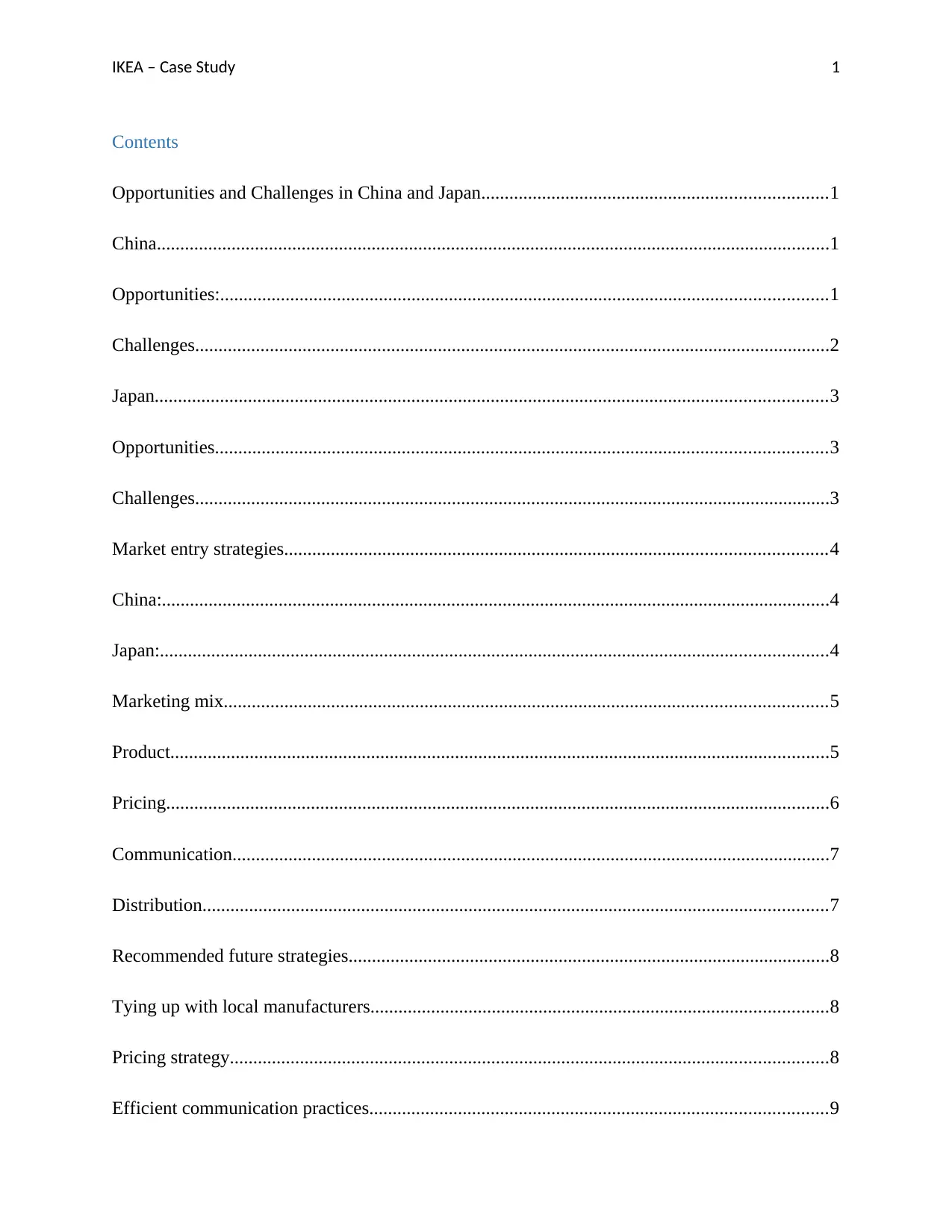
IKEA – Case Study 1
Contents
Opportunities and Challenges in China and Japan..........................................................................1
China................................................................................................................................................1
Opportunities:..................................................................................................................................1
Challenges........................................................................................................................................2
Japan................................................................................................................................................3
Opportunities...................................................................................................................................3
Challenges........................................................................................................................................3
Market entry strategies....................................................................................................................4
China:...............................................................................................................................................4
Japan:...............................................................................................................................................4
Marketing mix.................................................................................................................................5
Product.............................................................................................................................................5
Pricing..............................................................................................................................................6
Communication................................................................................................................................7
Distribution......................................................................................................................................7
Recommended future strategies.......................................................................................................8
Tying up with local manufacturers..................................................................................................8
Pricing strategy................................................................................................................................8
Efficient communication practices..................................................................................................9
Contents
Opportunities and Challenges in China and Japan..........................................................................1
China................................................................................................................................................1
Opportunities:..................................................................................................................................1
Challenges........................................................................................................................................2
Japan................................................................................................................................................3
Opportunities...................................................................................................................................3
Challenges........................................................................................................................................3
Market entry strategies....................................................................................................................4
China:...............................................................................................................................................4
Japan:...............................................................................................................................................4
Marketing mix.................................................................................................................................5
Product.............................................................................................................................................5
Pricing..............................................................................................................................................6
Communication................................................................................................................................7
Distribution......................................................................................................................................7
Recommended future strategies.......................................................................................................8
Tying up with local manufacturers..................................................................................................8
Pricing strategy................................................................................................................................8
Efficient communication practices..................................................................................................9

IKEA – Case Study 2
References......................................................................................................................................10
References......................................................................................................................................10
⊘ This is a preview!⊘
Do you want full access?
Subscribe today to unlock all pages.

Trusted by 1+ million students worldwide
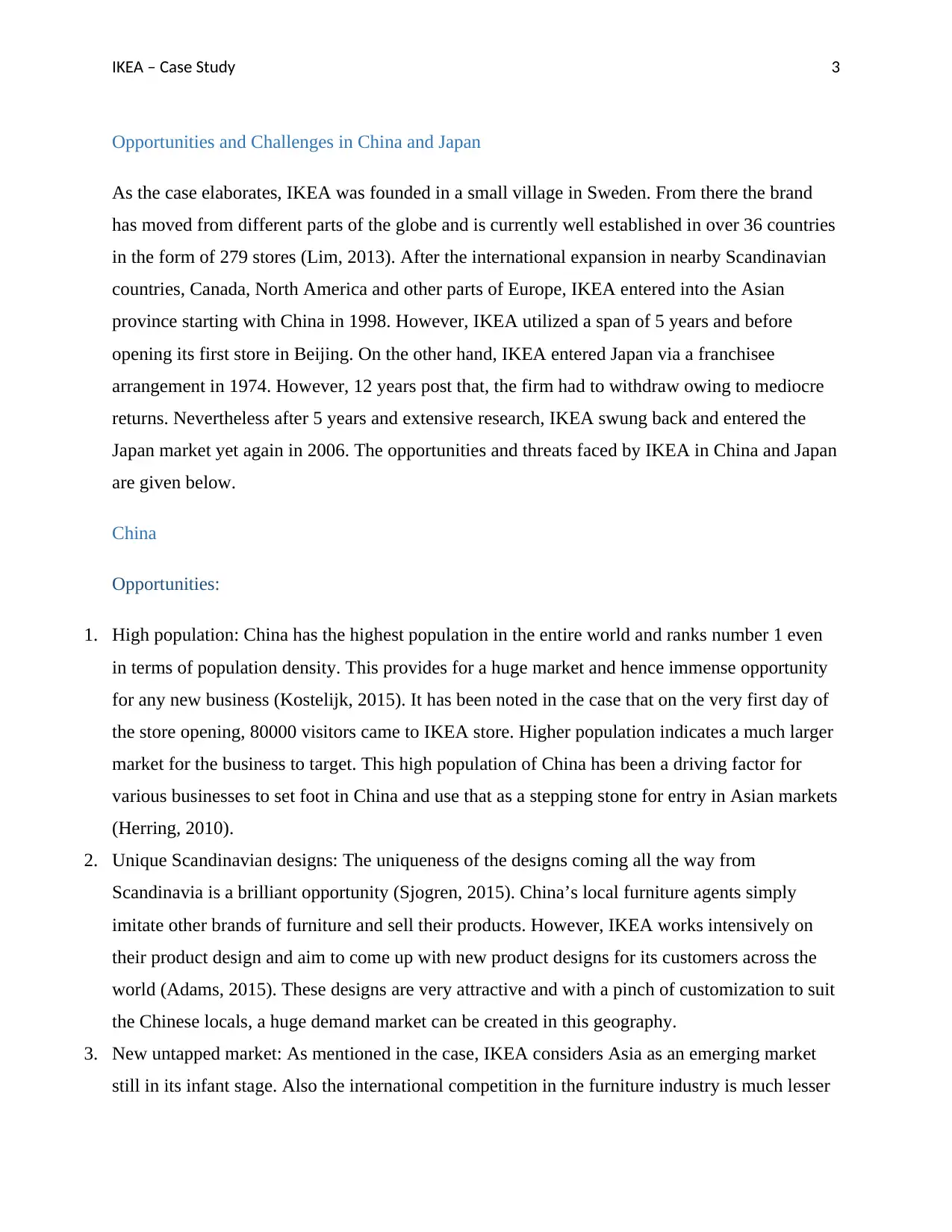
IKEA – Case Study 3
Opportunities and Challenges in China and Japan
As the case elaborates, IKEA was founded in a small village in Sweden. From there the brand
has moved from different parts of the globe and is currently well established in over 36 countries
in the form of 279 stores (Lim, 2013). After the international expansion in nearby Scandinavian
countries, Canada, North America and other parts of Europe, IKEA entered into the Asian
province starting with China in 1998. However, IKEA utilized a span of 5 years and before
opening its first store in Beijing. On the other hand, IKEA entered Japan via a franchisee
arrangement in 1974. However, 12 years post that, the firm had to withdraw owing to mediocre
returns. Nevertheless after 5 years and extensive research, IKEA swung back and entered the
Japan market yet again in 2006. The opportunities and threats faced by IKEA in China and Japan
are given below.
China
Opportunities:
1. High population: China has the highest population in the entire world and ranks number 1 even
in terms of population density. This provides for a huge market and hence immense opportunity
for any new business (Kostelijk, 2015). It has been noted in the case that on the very first day of
the store opening, 80000 visitors came to IKEA store. Higher population indicates a much larger
market for the business to target. This high population of China has been a driving factor for
various businesses to set foot in China and use that as a stepping stone for entry in Asian markets
(Herring, 2010).
2. Unique Scandinavian designs: The uniqueness of the designs coming all the way from
Scandinavia is a brilliant opportunity (Sjogren, 2015). China’s local furniture agents simply
imitate other brands of furniture and sell their products. However, IKEA works intensively on
their product design and aim to come up with new product designs for its customers across the
world (Adams, 2015). These designs are very attractive and with a pinch of customization to suit
the Chinese locals, a huge demand market can be created in this geography.
3. New untapped market: As mentioned in the case, IKEA considers Asia as an emerging market
still in its infant stage. Also the international competition in the furniture industry is much lesser
Opportunities and Challenges in China and Japan
As the case elaborates, IKEA was founded in a small village in Sweden. From there the brand
has moved from different parts of the globe and is currently well established in over 36 countries
in the form of 279 stores (Lim, 2013). After the international expansion in nearby Scandinavian
countries, Canada, North America and other parts of Europe, IKEA entered into the Asian
province starting with China in 1998. However, IKEA utilized a span of 5 years and before
opening its first store in Beijing. On the other hand, IKEA entered Japan via a franchisee
arrangement in 1974. However, 12 years post that, the firm had to withdraw owing to mediocre
returns. Nevertheless after 5 years and extensive research, IKEA swung back and entered the
Japan market yet again in 2006. The opportunities and threats faced by IKEA in China and Japan
are given below.
China
Opportunities:
1. High population: China has the highest population in the entire world and ranks number 1 even
in terms of population density. This provides for a huge market and hence immense opportunity
for any new business (Kostelijk, 2015). It has been noted in the case that on the very first day of
the store opening, 80000 visitors came to IKEA store. Higher population indicates a much larger
market for the business to target. This high population of China has been a driving factor for
various businesses to set foot in China and use that as a stepping stone for entry in Asian markets
(Herring, 2010).
2. Unique Scandinavian designs: The uniqueness of the designs coming all the way from
Scandinavia is a brilliant opportunity (Sjogren, 2015). China’s local furniture agents simply
imitate other brands of furniture and sell their products. However, IKEA works intensively on
their product design and aim to come up with new product designs for its customers across the
world (Adams, 2015). These designs are very attractive and with a pinch of customization to suit
the Chinese locals, a huge demand market can be created in this geography.
3. New untapped market: As mentioned in the case, IKEA considers Asia as an emerging market
still in its infant stage. Also the international competition in the furniture industry is much lesser
Paraphrase This Document
Need a fresh take? Get an instant paraphrase of this document with our AI Paraphraser
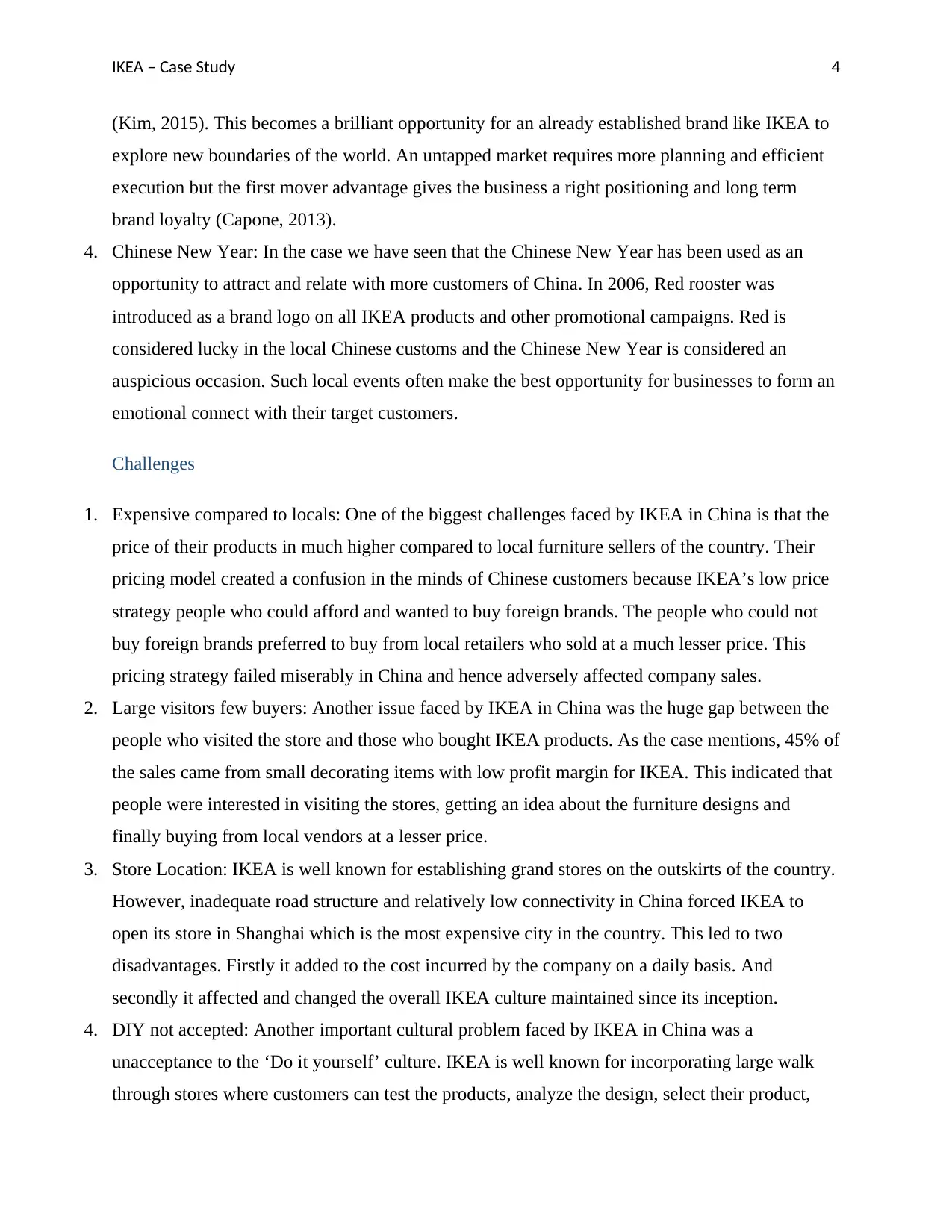
IKEA – Case Study 4
(Kim, 2015). This becomes a brilliant opportunity for an already established brand like IKEA to
explore new boundaries of the world. An untapped market requires more planning and efficient
execution but the first mover advantage gives the business a right positioning and long term
brand loyalty (Capone, 2013).
4. Chinese New Year: In the case we have seen that the Chinese New Year has been used as an
opportunity to attract and relate with more customers of China. In 2006, Red rooster was
introduced as a brand logo on all IKEA products and other promotional campaigns. Red is
considered lucky in the local Chinese customs and the Chinese New Year is considered an
auspicious occasion. Such local events often make the best opportunity for businesses to form an
emotional connect with their target customers.
Challenges
1. Expensive compared to locals: One of the biggest challenges faced by IKEA in China is that the
price of their products in much higher compared to local furniture sellers of the country. Their
pricing model created a confusion in the minds of Chinese customers because IKEA’s low price
strategy people who could afford and wanted to buy foreign brands. The people who could not
buy foreign brands preferred to buy from local retailers who sold at a much lesser price. This
pricing strategy failed miserably in China and hence adversely affected company sales.
2. Large visitors few buyers: Another issue faced by IKEA in China was the huge gap between the
people who visited the store and those who bought IKEA products. As the case mentions, 45% of
the sales came from small decorating items with low profit margin for IKEA. This indicated that
people were interested in visiting the stores, getting an idea about the furniture designs and
finally buying from local vendors at a lesser price.
3. Store Location: IKEA is well known for establishing grand stores on the outskirts of the country.
However, inadequate road structure and relatively low connectivity in China forced IKEA to
open its store in Shanghai which is the most expensive city in the country. This led to two
disadvantages. Firstly it added to the cost incurred by the company on a daily basis. And
secondly it affected and changed the overall IKEA culture maintained since its inception.
4. DIY not accepted: Another important cultural problem faced by IKEA in China was a
unacceptance to the ‘Do it yourself’ culture. IKEA is well known for incorporating large walk
through stores where customers can test the products, analyze the design, select their product,
(Kim, 2015). This becomes a brilliant opportunity for an already established brand like IKEA to
explore new boundaries of the world. An untapped market requires more planning and efficient
execution but the first mover advantage gives the business a right positioning and long term
brand loyalty (Capone, 2013).
4. Chinese New Year: In the case we have seen that the Chinese New Year has been used as an
opportunity to attract and relate with more customers of China. In 2006, Red rooster was
introduced as a brand logo on all IKEA products and other promotional campaigns. Red is
considered lucky in the local Chinese customs and the Chinese New Year is considered an
auspicious occasion. Such local events often make the best opportunity for businesses to form an
emotional connect with their target customers.
Challenges
1. Expensive compared to locals: One of the biggest challenges faced by IKEA in China is that the
price of their products in much higher compared to local furniture sellers of the country. Their
pricing model created a confusion in the minds of Chinese customers because IKEA’s low price
strategy people who could afford and wanted to buy foreign brands. The people who could not
buy foreign brands preferred to buy from local retailers who sold at a much lesser price. This
pricing strategy failed miserably in China and hence adversely affected company sales.
2. Large visitors few buyers: Another issue faced by IKEA in China was the huge gap between the
people who visited the store and those who bought IKEA products. As the case mentions, 45% of
the sales came from small decorating items with low profit margin for IKEA. This indicated that
people were interested in visiting the stores, getting an idea about the furniture designs and
finally buying from local vendors at a lesser price.
3. Store Location: IKEA is well known for establishing grand stores on the outskirts of the country.
However, inadequate road structure and relatively low connectivity in China forced IKEA to
open its store in Shanghai which is the most expensive city in the country. This led to two
disadvantages. Firstly it added to the cost incurred by the company on a daily basis. And
secondly it affected and changed the overall IKEA culture maintained since its inception.
4. DIY not accepted: Another important cultural problem faced by IKEA in China was a
unacceptance to the ‘Do it yourself’ culture. IKEA is well known for incorporating large walk
through stores where customers can test the products, analyze the design, select their product,
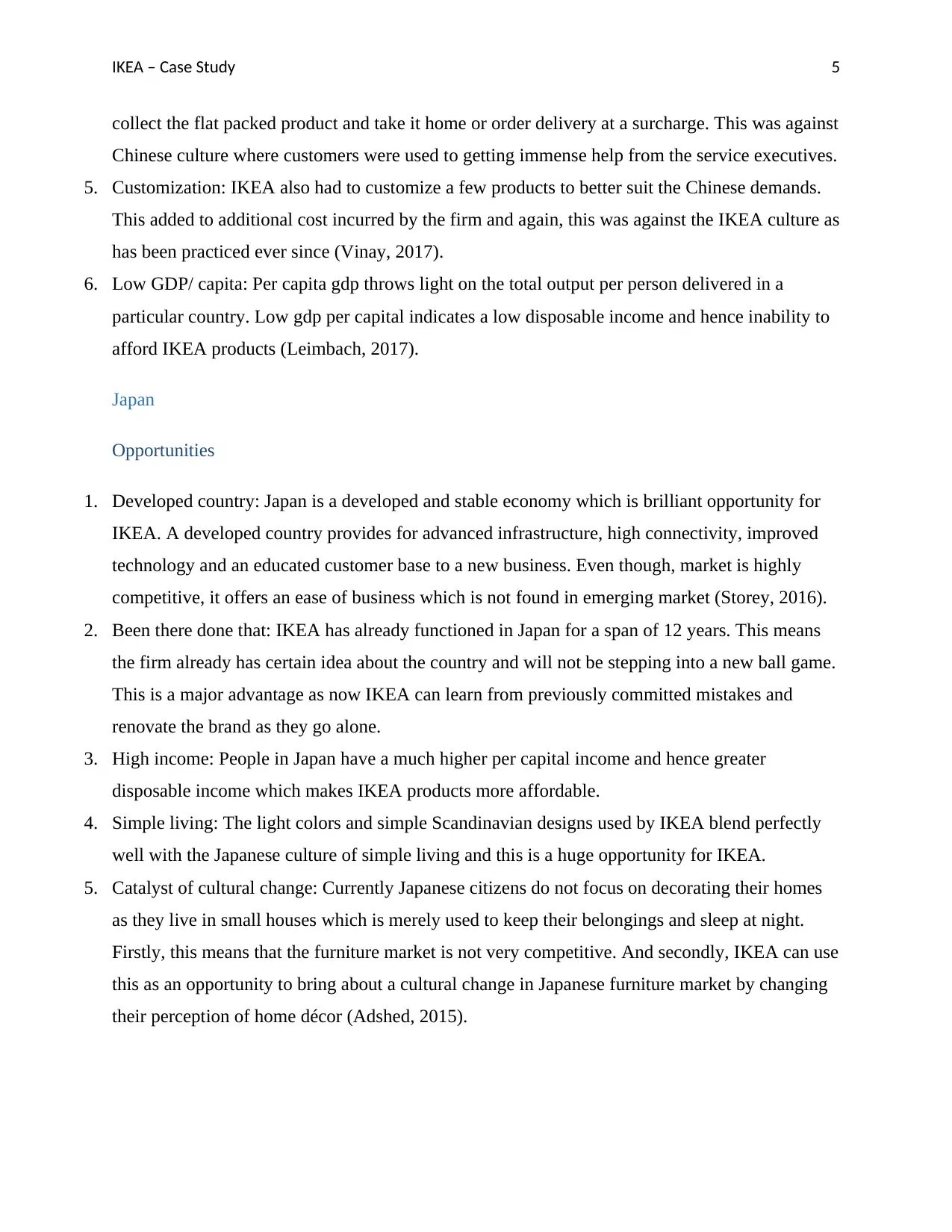
IKEA – Case Study 5
collect the flat packed product and take it home or order delivery at a surcharge. This was against
Chinese culture where customers were used to getting immense help from the service executives.
5. Customization: IKEA also had to customize a few products to better suit the Chinese demands.
This added to additional cost incurred by the firm and again, this was against the IKEA culture as
has been practiced ever since (Vinay, 2017).
6. Low GDP/ capita: Per capita gdp throws light on the total output per person delivered in a
particular country. Low gdp per capital indicates a low disposable income and hence inability to
afford IKEA products (Leimbach, 2017).
Japan
Opportunities
1. Developed country: Japan is a developed and stable economy which is brilliant opportunity for
IKEA. A developed country provides for advanced infrastructure, high connectivity, improved
technology and an educated customer base to a new business. Even though, market is highly
competitive, it offers an ease of business which is not found in emerging market (Storey, 2016).
2. Been there done that: IKEA has already functioned in Japan for a span of 12 years. This means
the firm already has certain idea about the country and will not be stepping into a new ball game.
This is a major advantage as now IKEA can learn from previously committed mistakes and
renovate the brand as they go alone.
3. High income: People in Japan have a much higher per capital income and hence greater
disposable income which makes IKEA products more affordable.
4. Simple living: The light colors and simple Scandinavian designs used by IKEA blend perfectly
well with the Japanese culture of simple living and this is a huge opportunity for IKEA.
5. Catalyst of cultural change: Currently Japanese citizens do not focus on decorating their homes
as they live in small houses which is merely used to keep their belongings and sleep at night.
Firstly, this means that the furniture market is not very competitive. And secondly, IKEA can use
this as an opportunity to bring about a cultural change in Japanese furniture market by changing
their perception of home décor (Adshed, 2015).
collect the flat packed product and take it home or order delivery at a surcharge. This was against
Chinese culture where customers were used to getting immense help from the service executives.
5. Customization: IKEA also had to customize a few products to better suit the Chinese demands.
This added to additional cost incurred by the firm and again, this was against the IKEA culture as
has been practiced ever since (Vinay, 2017).
6. Low GDP/ capita: Per capita gdp throws light on the total output per person delivered in a
particular country. Low gdp per capital indicates a low disposable income and hence inability to
afford IKEA products (Leimbach, 2017).
Japan
Opportunities
1. Developed country: Japan is a developed and stable economy which is brilliant opportunity for
IKEA. A developed country provides for advanced infrastructure, high connectivity, improved
technology and an educated customer base to a new business. Even though, market is highly
competitive, it offers an ease of business which is not found in emerging market (Storey, 2016).
2. Been there done that: IKEA has already functioned in Japan for a span of 12 years. This means
the firm already has certain idea about the country and will not be stepping into a new ball game.
This is a major advantage as now IKEA can learn from previously committed mistakes and
renovate the brand as they go alone.
3. High income: People in Japan have a much higher per capital income and hence greater
disposable income which makes IKEA products more affordable.
4. Simple living: The light colors and simple Scandinavian designs used by IKEA blend perfectly
well with the Japanese culture of simple living and this is a huge opportunity for IKEA.
5. Catalyst of cultural change: Currently Japanese citizens do not focus on decorating their homes
as they live in small houses which is merely used to keep their belongings and sleep at night.
Firstly, this means that the furniture market is not very competitive. And secondly, IKEA can use
this as an opportunity to bring about a cultural change in Japanese furniture market by changing
their perception of home décor (Adshed, 2015).
⊘ This is a preview!⊘
Do you want full access?
Subscribe today to unlock all pages.

Trusted by 1+ million students worldwide
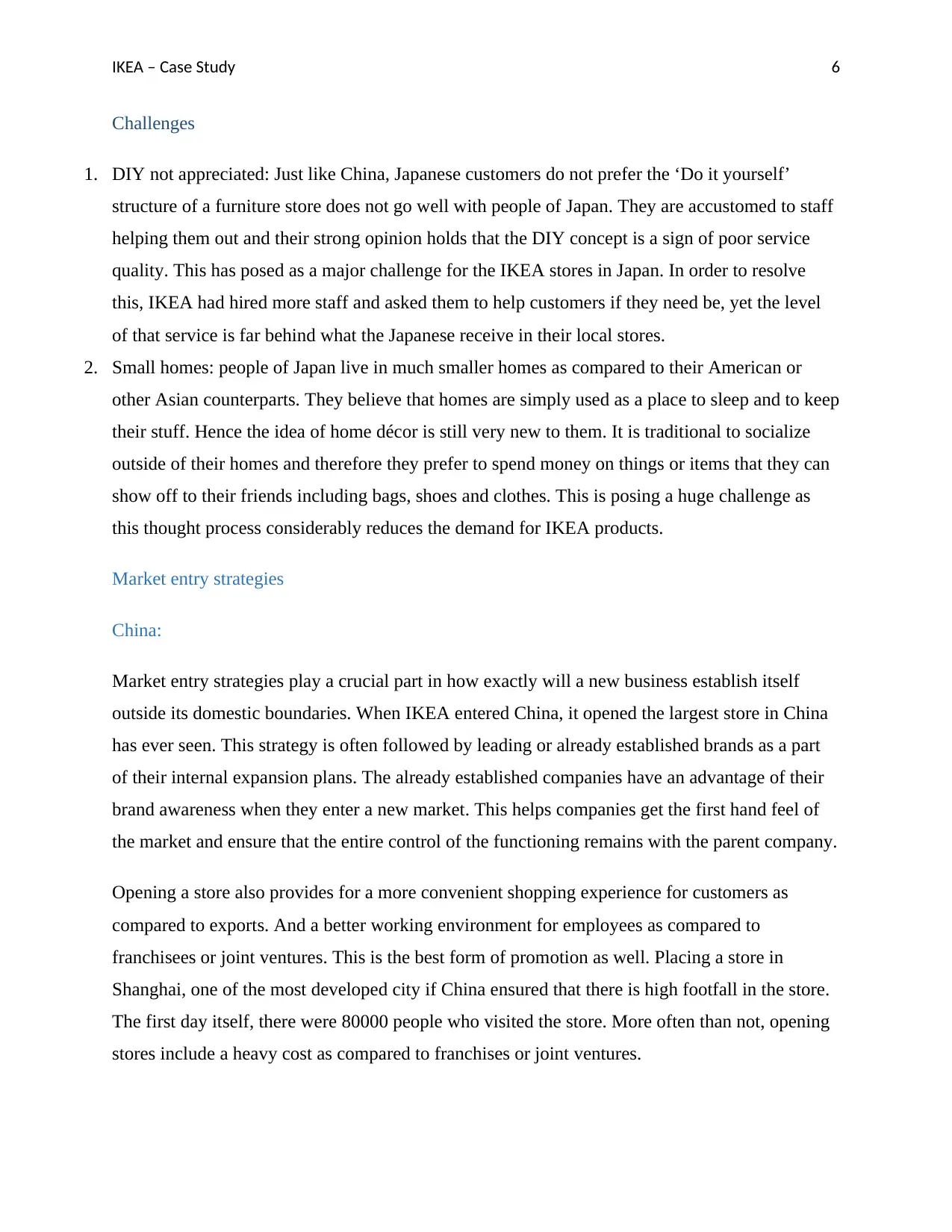
IKEA – Case Study 6
Challenges
1. DIY not appreciated: Just like China, Japanese customers do not prefer the ‘Do it yourself’
structure of a furniture store does not go well with people of Japan. They are accustomed to staff
helping them out and their strong opinion holds that the DIY concept is a sign of poor service
quality. This has posed as a major challenge for the IKEA stores in Japan. In order to resolve
this, IKEA had hired more staff and asked them to help customers if they need be, yet the level
of that service is far behind what the Japanese receive in their local stores.
2. Small homes: people of Japan live in much smaller homes as compared to their American or
other Asian counterparts. They believe that homes are simply used as a place to sleep and to keep
their stuff. Hence the idea of home décor is still very new to them. It is traditional to socialize
outside of their homes and therefore they prefer to spend money on things or items that they can
show off to their friends including bags, shoes and clothes. This is posing a huge challenge as
this thought process considerably reduces the demand for IKEA products.
Market entry strategies
China:
Market entry strategies play a crucial part in how exactly will a new business establish itself
outside its domestic boundaries. When IKEA entered China, it opened the largest store in China
has ever seen. This strategy is often followed by leading or already established brands as a part
of their internal expansion plans. The already established companies have an advantage of their
brand awareness when they enter a new market. This helps companies get the first hand feel of
the market and ensure that the entire control of the functioning remains with the parent company.
Opening a store also provides for a more convenient shopping experience for customers as
compared to exports. And a better working environment for employees as compared to
franchisees or joint ventures. This is the best form of promotion as well. Placing a store in
Shanghai, one of the most developed city if China ensured that there is high footfall in the store.
The first day itself, there were 80000 people who visited the store. More often than not, opening
stores include a heavy cost as compared to franchises or joint ventures.
Challenges
1. DIY not appreciated: Just like China, Japanese customers do not prefer the ‘Do it yourself’
structure of a furniture store does not go well with people of Japan. They are accustomed to staff
helping them out and their strong opinion holds that the DIY concept is a sign of poor service
quality. This has posed as a major challenge for the IKEA stores in Japan. In order to resolve
this, IKEA had hired more staff and asked them to help customers if they need be, yet the level
of that service is far behind what the Japanese receive in their local stores.
2. Small homes: people of Japan live in much smaller homes as compared to their American or
other Asian counterparts. They believe that homes are simply used as a place to sleep and to keep
their stuff. Hence the idea of home décor is still very new to them. It is traditional to socialize
outside of their homes and therefore they prefer to spend money on things or items that they can
show off to their friends including bags, shoes and clothes. This is posing a huge challenge as
this thought process considerably reduces the demand for IKEA products.
Market entry strategies
China:
Market entry strategies play a crucial part in how exactly will a new business establish itself
outside its domestic boundaries. When IKEA entered China, it opened the largest store in China
has ever seen. This strategy is often followed by leading or already established brands as a part
of their internal expansion plans. The already established companies have an advantage of their
brand awareness when they enter a new market. This helps companies get the first hand feel of
the market and ensure that the entire control of the functioning remains with the parent company.
Opening a store also provides for a more convenient shopping experience for customers as
compared to exports. And a better working environment for employees as compared to
franchisees or joint ventures. This is the best form of promotion as well. Placing a store in
Shanghai, one of the most developed city if China ensured that there is high footfall in the store.
The first day itself, there were 80000 people who visited the store. More often than not, opening
stores include a heavy cost as compared to franchises or joint ventures.
Paraphrase This Document
Need a fresh take? Get an instant paraphrase of this document with our AI Paraphraser
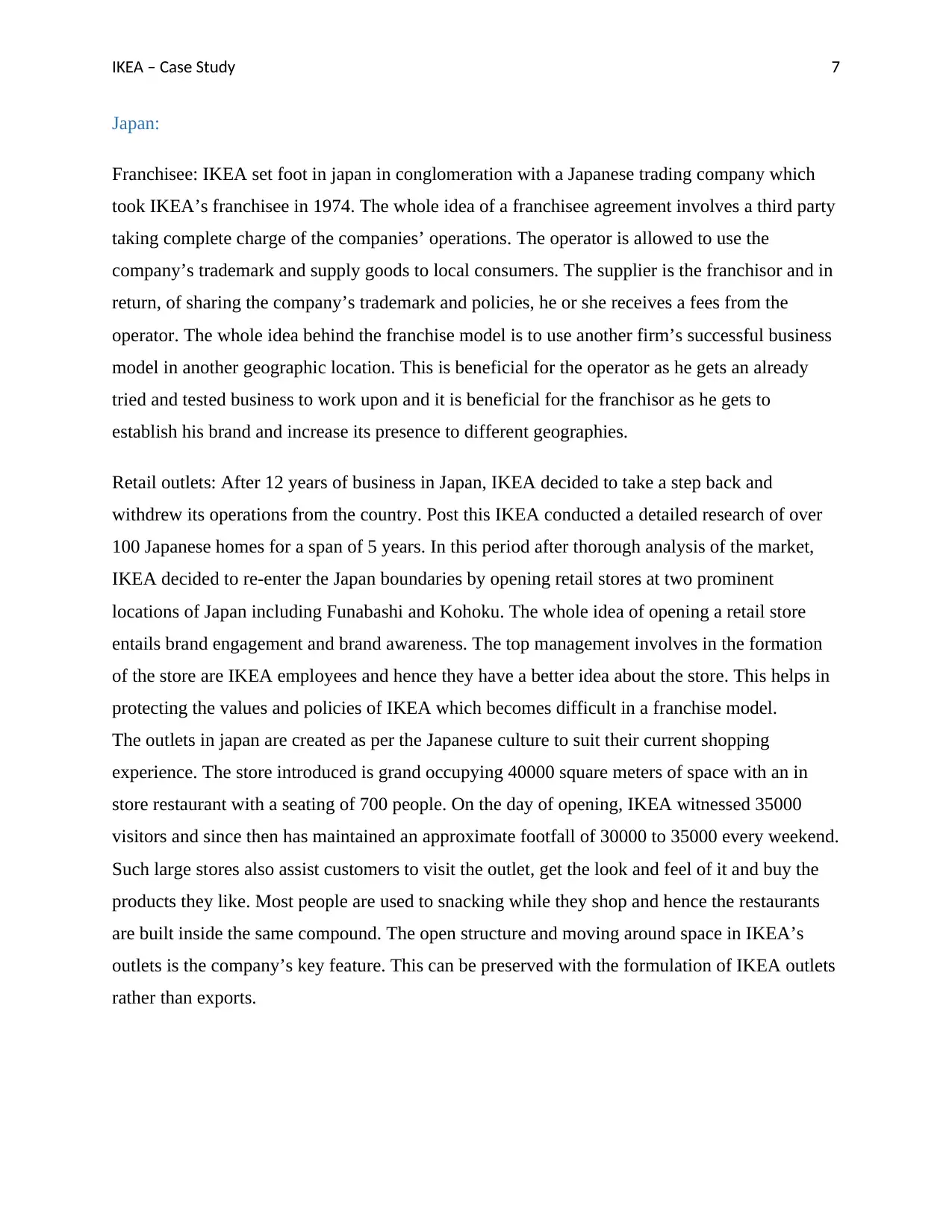
IKEA – Case Study 7
Japan:
Franchisee: IKEA set foot in japan in conglomeration with a Japanese trading company which
took IKEA’s franchisee in 1974. The whole idea of a franchisee agreement involves a third party
taking complete charge of the companies’ operations. The operator is allowed to use the
company’s trademark and supply goods to local consumers. The supplier is the franchisor and in
return, of sharing the company’s trademark and policies, he or she receives a fees from the
operator. The whole idea behind the franchise model is to use another firm’s successful business
model in another geographic location. This is beneficial for the operator as he gets an already
tried and tested business to work upon and it is beneficial for the franchisor as he gets to
establish his brand and increase its presence to different geographies.
Retail outlets: After 12 years of business in Japan, IKEA decided to take a step back and
withdrew its operations from the country. Post this IKEA conducted a detailed research of over
100 Japanese homes for a span of 5 years. In this period after thorough analysis of the market,
IKEA decided to re-enter the Japan boundaries by opening retail stores at two prominent
locations of Japan including Funabashi and Kohoku. The whole idea of opening a retail store
entails brand engagement and brand awareness. The top management involves in the formation
of the store are IKEA employees and hence they have a better idea about the store. This helps in
protecting the values and policies of IKEA which becomes difficult in a franchise model.
The outlets in japan are created as per the Japanese culture to suit their current shopping
experience. The store introduced is grand occupying 40000 square meters of space with an in
store restaurant with a seating of 700 people. On the day of opening, IKEA witnessed 35000
visitors and since then has maintained an approximate footfall of 30000 to 35000 every weekend.
Such large stores also assist customers to visit the outlet, get the look and feel of it and buy the
products they like. Most people are used to snacking while they shop and hence the restaurants
are built inside the same compound. The open structure and moving around space in IKEA’s
outlets is the company’s key feature. This can be preserved with the formulation of IKEA outlets
rather than exports.
Japan:
Franchisee: IKEA set foot in japan in conglomeration with a Japanese trading company which
took IKEA’s franchisee in 1974. The whole idea of a franchisee agreement involves a third party
taking complete charge of the companies’ operations. The operator is allowed to use the
company’s trademark and supply goods to local consumers. The supplier is the franchisor and in
return, of sharing the company’s trademark and policies, he or she receives a fees from the
operator. The whole idea behind the franchise model is to use another firm’s successful business
model in another geographic location. This is beneficial for the operator as he gets an already
tried and tested business to work upon and it is beneficial for the franchisor as he gets to
establish his brand and increase its presence to different geographies.
Retail outlets: After 12 years of business in Japan, IKEA decided to take a step back and
withdrew its operations from the country. Post this IKEA conducted a detailed research of over
100 Japanese homes for a span of 5 years. In this period after thorough analysis of the market,
IKEA decided to re-enter the Japan boundaries by opening retail stores at two prominent
locations of Japan including Funabashi and Kohoku. The whole idea of opening a retail store
entails brand engagement and brand awareness. The top management involves in the formation
of the store are IKEA employees and hence they have a better idea about the store. This helps in
protecting the values and policies of IKEA which becomes difficult in a franchise model.
The outlets in japan are created as per the Japanese culture to suit their current shopping
experience. The store introduced is grand occupying 40000 square meters of space with an in
store restaurant with a seating of 700 people. On the day of opening, IKEA witnessed 35000
visitors and since then has maintained an approximate footfall of 30000 to 35000 every weekend.
Such large stores also assist customers to visit the outlet, get the look and feel of it and buy the
products they like. Most people are used to snacking while they shop and hence the restaurants
are built inside the same compound. The open structure and moving around space in IKEA’s
outlets is the company’s key feature. This can be preserved with the formulation of IKEA outlets
rather than exports.
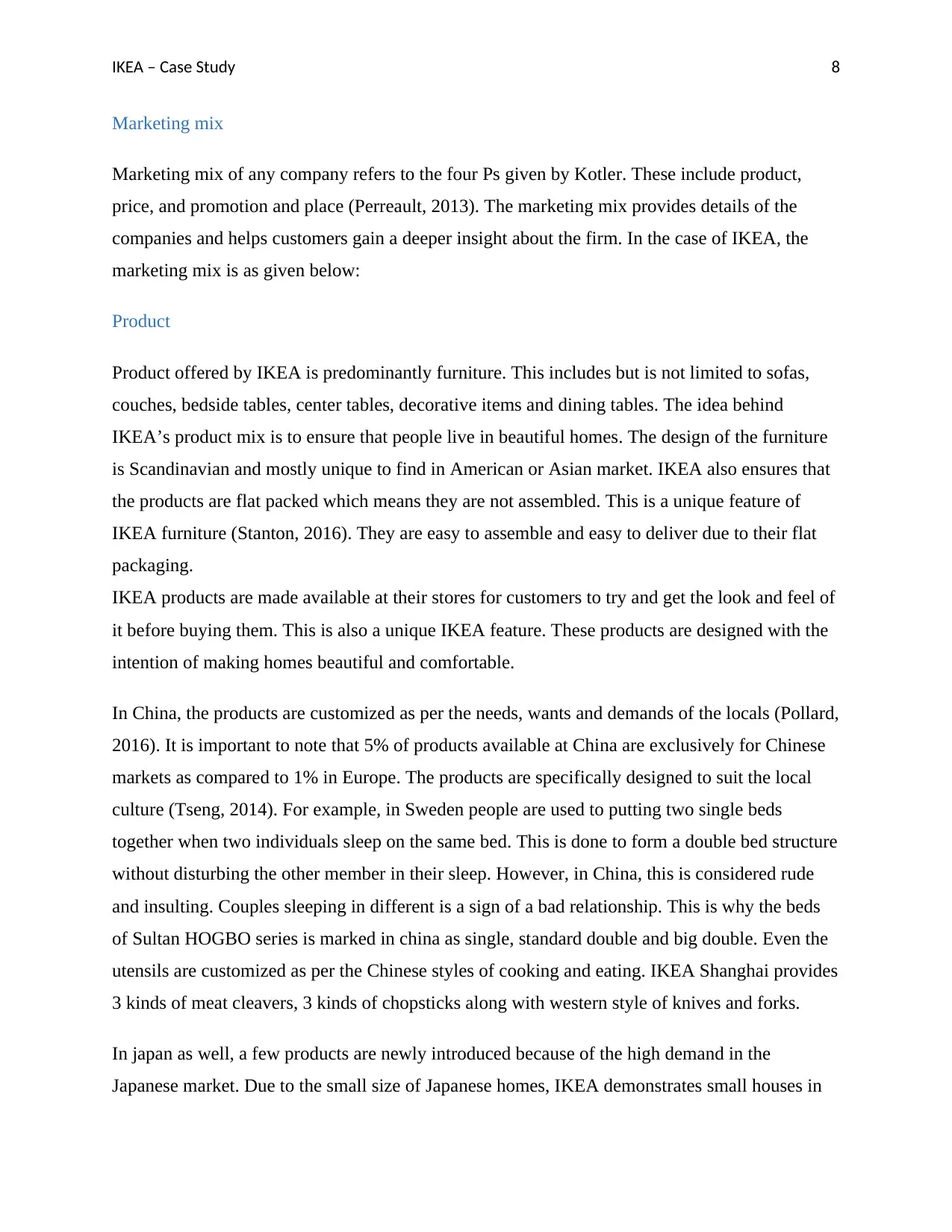
IKEA – Case Study 8
Marketing mix
Marketing mix of any company refers to the four Ps given by Kotler. These include product,
price, and promotion and place (Perreault, 2013). The marketing mix provides details of the
companies and helps customers gain a deeper insight about the firm. In the case of IKEA, the
marketing mix is as given below:
Product
Product offered by IKEA is predominantly furniture. This includes but is not limited to sofas,
couches, bedside tables, center tables, decorative items and dining tables. The idea behind
IKEA’s product mix is to ensure that people live in beautiful homes. The design of the furniture
is Scandinavian and mostly unique to find in American or Asian market. IKEA also ensures that
the products are flat packed which means they are not assembled. This is a unique feature of
IKEA furniture (Stanton, 2016). They are easy to assemble and easy to deliver due to their flat
packaging.
IKEA products are made available at their stores for customers to try and get the look and feel of
it before buying them. This is also a unique IKEA feature. These products are designed with the
intention of making homes beautiful and comfortable.
In China, the products are customized as per the needs, wants and demands of the locals (Pollard,
2016). It is important to note that 5% of products available at China are exclusively for Chinese
markets as compared to 1% in Europe. The products are specifically designed to suit the local
culture (Tseng, 2014). For example, in Sweden people are used to putting two single beds
together when two individuals sleep on the same bed. This is done to form a double bed structure
without disturbing the other member in their sleep. However, in China, this is considered rude
and insulting. Couples sleeping in different is a sign of a bad relationship. This is why the beds
of Sultan HOGBO series is marked in china as single, standard double and big double. Even the
utensils are customized as per the Chinese styles of cooking and eating. IKEA Shanghai provides
3 kinds of meat cleavers, 3 kinds of chopsticks along with western style of knives and forks.
In japan as well, a few products are newly introduced because of the high demand in the
Japanese market. Due to the small size of Japanese homes, IKEA demonstrates small houses in
Marketing mix
Marketing mix of any company refers to the four Ps given by Kotler. These include product,
price, and promotion and place (Perreault, 2013). The marketing mix provides details of the
companies and helps customers gain a deeper insight about the firm. In the case of IKEA, the
marketing mix is as given below:
Product
Product offered by IKEA is predominantly furniture. This includes but is not limited to sofas,
couches, bedside tables, center tables, decorative items and dining tables. The idea behind
IKEA’s product mix is to ensure that people live in beautiful homes. The design of the furniture
is Scandinavian and mostly unique to find in American or Asian market. IKEA also ensures that
the products are flat packed which means they are not assembled. This is a unique feature of
IKEA furniture (Stanton, 2016). They are easy to assemble and easy to deliver due to their flat
packaging.
IKEA products are made available at their stores for customers to try and get the look and feel of
it before buying them. This is also a unique IKEA feature. These products are designed with the
intention of making homes beautiful and comfortable.
In China, the products are customized as per the needs, wants and demands of the locals (Pollard,
2016). It is important to note that 5% of products available at China are exclusively for Chinese
markets as compared to 1% in Europe. The products are specifically designed to suit the local
culture (Tseng, 2014). For example, in Sweden people are used to putting two single beds
together when two individuals sleep on the same bed. This is done to form a double bed structure
without disturbing the other member in their sleep. However, in China, this is considered rude
and insulting. Couples sleeping in different is a sign of a bad relationship. This is why the beds
of Sultan HOGBO series is marked in china as single, standard double and big double. Even the
utensils are customized as per the Chinese styles of cooking and eating. IKEA Shanghai provides
3 kinds of meat cleavers, 3 kinds of chopsticks along with western style of knives and forks.
In japan as well, a few products are newly introduced because of the high demand in the
Japanese market. Due to the small size of Japanese homes, IKEA demonstrates small houses in
⊘ This is a preview!⊘
Do you want full access?
Subscribe today to unlock all pages.

Trusted by 1+ million students worldwide
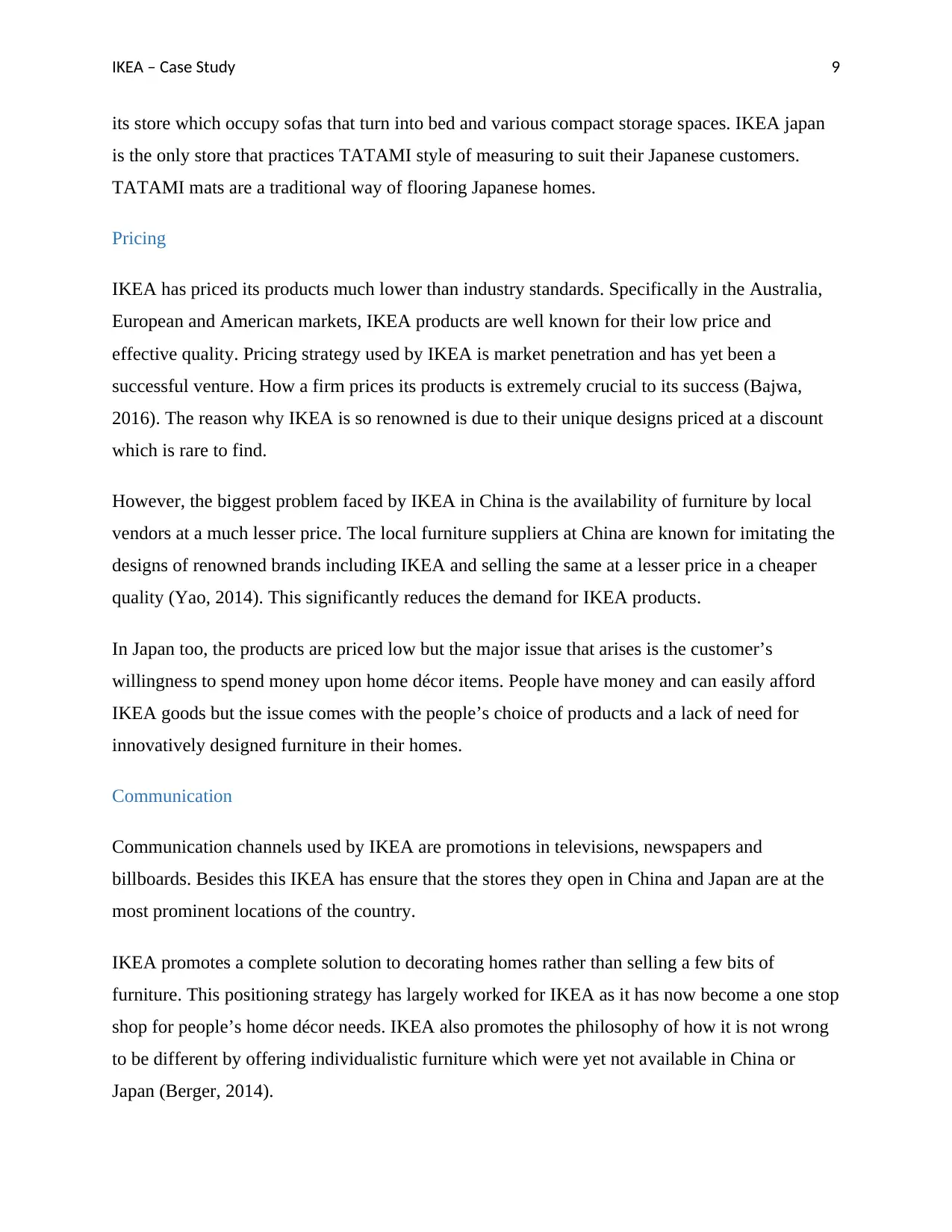
IKEA – Case Study 9
its store which occupy sofas that turn into bed and various compact storage spaces. IKEA japan
is the only store that practices TATAMI style of measuring to suit their Japanese customers.
TATAMI mats are a traditional way of flooring Japanese homes.
Pricing
IKEA has priced its products much lower than industry standards. Specifically in the Australia,
European and American markets, IKEA products are well known for their low price and
effective quality. Pricing strategy used by IKEA is market penetration and has yet been a
successful venture. How a firm prices its products is extremely crucial to its success (Bajwa,
2016). The reason why IKEA is so renowned is due to their unique designs priced at a discount
which is rare to find.
However, the biggest problem faced by IKEA in China is the availability of furniture by local
vendors at a much lesser price. The local furniture suppliers at China are known for imitating the
designs of renowned brands including IKEA and selling the same at a lesser price in a cheaper
quality (Yao, 2014). This significantly reduces the demand for IKEA products.
In Japan too, the products are priced low but the major issue that arises is the customer’s
willingness to spend money upon home décor items. People have money and can easily afford
IKEA goods but the issue comes with the people’s choice of products and a lack of need for
innovatively designed furniture in their homes.
Communication
Communication channels used by IKEA are promotions in televisions, newspapers and
billboards. Besides this IKEA has ensure that the stores they open in China and Japan are at the
most prominent locations of the country.
IKEA promotes a complete solution to decorating homes rather than selling a few bits of
furniture. This positioning strategy has largely worked for IKEA as it has now become a one stop
shop for people’s home décor needs. IKEA also promotes the philosophy of how it is not wrong
to be different by offering individualistic furniture which were yet not available in China or
Japan (Berger, 2014).
its store which occupy sofas that turn into bed and various compact storage spaces. IKEA japan
is the only store that practices TATAMI style of measuring to suit their Japanese customers.
TATAMI mats are a traditional way of flooring Japanese homes.
Pricing
IKEA has priced its products much lower than industry standards. Specifically in the Australia,
European and American markets, IKEA products are well known for their low price and
effective quality. Pricing strategy used by IKEA is market penetration and has yet been a
successful venture. How a firm prices its products is extremely crucial to its success (Bajwa,
2016). The reason why IKEA is so renowned is due to their unique designs priced at a discount
which is rare to find.
However, the biggest problem faced by IKEA in China is the availability of furniture by local
vendors at a much lesser price. The local furniture suppliers at China are known for imitating the
designs of renowned brands including IKEA and selling the same at a lesser price in a cheaper
quality (Yao, 2014). This significantly reduces the demand for IKEA products.
In Japan too, the products are priced low but the major issue that arises is the customer’s
willingness to spend money upon home décor items. People have money and can easily afford
IKEA goods but the issue comes with the people’s choice of products and a lack of need for
innovatively designed furniture in their homes.
Communication
Communication channels used by IKEA are promotions in televisions, newspapers and
billboards. Besides this IKEA has ensure that the stores they open in China and Japan are at the
most prominent locations of the country.
IKEA promotes a complete solution to decorating homes rather than selling a few bits of
furniture. This positioning strategy has largely worked for IKEA as it has now become a one stop
shop for people’s home décor needs. IKEA also promotes the philosophy of how it is not wrong
to be different by offering individualistic furniture which were yet not available in China or
Japan (Berger, 2014).
Paraphrase This Document
Need a fresh take? Get an instant paraphrase of this document with our AI Paraphraser
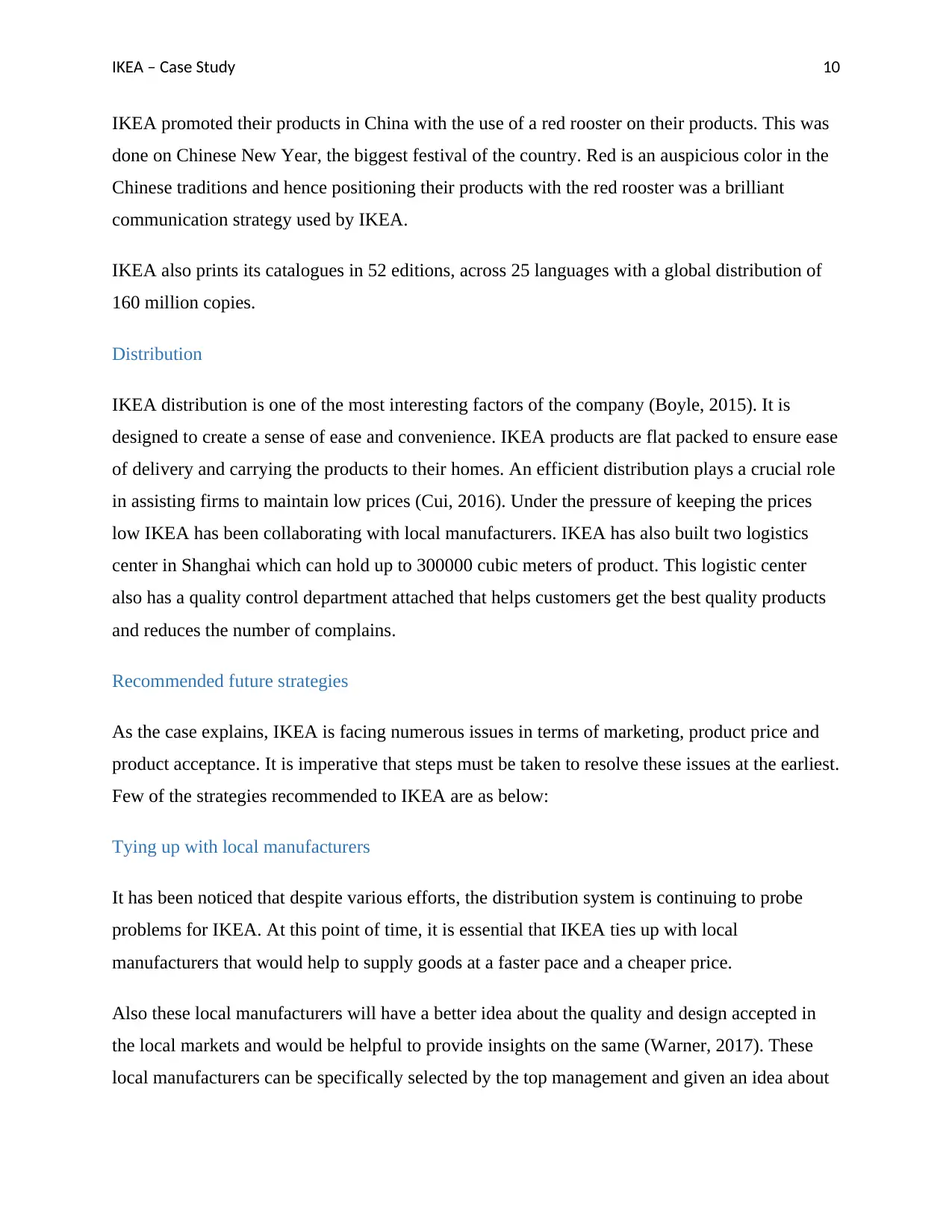
IKEA – Case Study 10
IKEA promoted their products in China with the use of a red rooster on their products. This was
done on Chinese New Year, the biggest festival of the country. Red is an auspicious color in the
Chinese traditions and hence positioning their products with the red rooster was a brilliant
communication strategy used by IKEA.
IKEA also prints its catalogues in 52 editions, across 25 languages with a global distribution of
160 million copies.
Distribution
IKEA distribution is one of the most interesting factors of the company (Boyle, 2015). It is
designed to create a sense of ease and convenience. IKEA products are flat packed to ensure ease
of delivery and carrying the products to their homes. An efficient distribution plays a crucial role
in assisting firms to maintain low prices (Cui, 2016). Under the pressure of keeping the prices
low IKEA has been collaborating with local manufacturers. IKEA has also built two logistics
center in Shanghai which can hold up to 300000 cubic meters of product. This logistic center
also has a quality control department attached that helps customers get the best quality products
and reduces the number of complains.
Recommended future strategies
As the case explains, IKEA is facing numerous issues in terms of marketing, product price and
product acceptance. It is imperative that steps must be taken to resolve these issues at the earliest.
Few of the strategies recommended to IKEA are as below:
Tying up with local manufacturers
It has been noticed that despite various efforts, the distribution system is continuing to probe
problems for IKEA. At this point of time, it is essential that IKEA ties up with local
manufacturers that would help to supply goods at a faster pace and a cheaper price.
Also these local manufacturers will have a better idea about the quality and design accepted in
the local markets and would be helpful to provide insights on the same (Warner, 2017). These
local manufacturers can be specifically selected by the top management and given an idea about
IKEA promoted their products in China with the use of a red rooster on their products. This was
done on Chinese New Year, the biggest festival of the country. Red is an auspicious color in the
Chinese traditions and hence positioning their products with the red rooster was a brilliant
communication strategy used by IKEA.
IKEA also prints its catalogues in 52 editions, across 25 languages with a global distribution of
160 million copies.
Distribution
IKEA distribution is one of the most interesting factors of the company (Boyle, 2015). It is
designed to create a sense of ease and convenience. IKEA products are flat packed to ensure ease
of delivery and carrying the products to their homes. An efficient distribution plays a crucial role
in assisting firms to maintain low prices (Cui, 2016). Under the pressure of keeping the prices
low IKEA has been collaborating with local manufacturers. IKEA has also built two logistics
center in Shanghai which can hold up to 300000 cubic meters of product. This logistic center
also has a quality control department attached that helps customers get the best quality products
and reduces the number of complains.
Recommended future strategies
As the case explains, IKEA is facing numerous issues in terms of marketing, product price and
product acceptance. It is imperative that steps must be taken to resolve these issues at the earliest.
Few of the strategies recommended to IKEA are as below:
Tying up with local manufacturers
It has been noticed that despite various efforts, the distribution system is continuing to probe
problems for IKEA. At this point of time, it is essential that IKEA ties up with local
manufacturers that would help to supply goods at a faster pace and a cheaper price.
Also these local manufacturers will have a better idea about the quality and design accepted in
the local markets and would be helpful to provide insights on the same (Warner, 2017). These
local manufacturers can be specifically selected by the top management and given an idea about
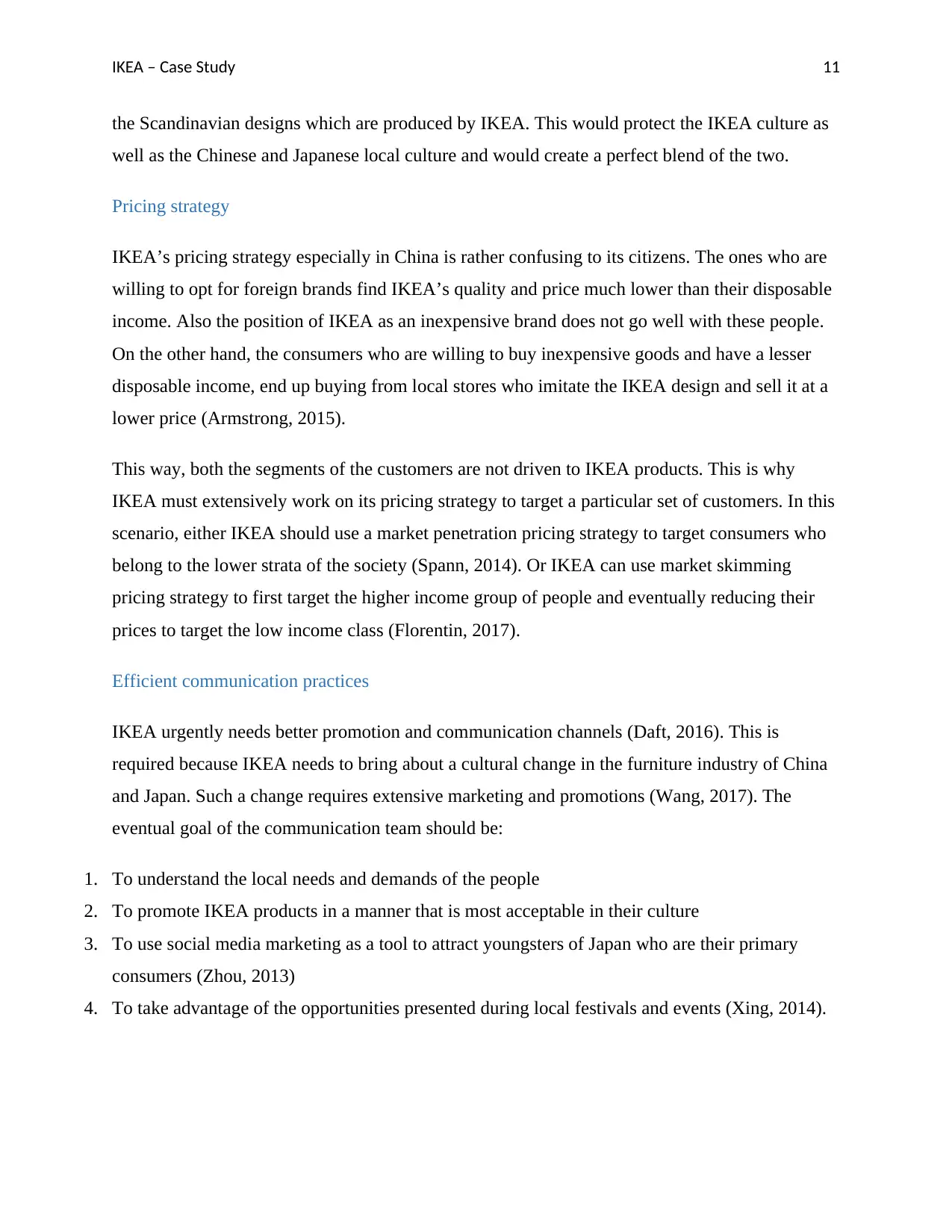
IKEA – Case Study 11
the Scandinavian designs which are produced by IKEA. This would protect the IKEA culture as
well as the Chinese and Japanese local culture and would create a perfect blend of the two.
Pricing strategy
IKEA’s pricing strategy especially in China is rather confusing to its citizens. The ones who are
willing to opt for foreign brands find IKEA’s quality and price much lower than their disposable
income. Also the position of IKEA as an inexpensive brand does not go well with these people.
On the other hand, the consumers who are willing to buy inexpensive goods and have a lesser
disposable income, end up buying from local stores who imitate the IKEA design and sell it at a
lower price (Armstrong, 2015).
This way, both the segments of the customers are not driven to IKEA products. This is why
IKEA must extensively work on its pricing strategy to target a particular set of customers. In this
scenario, either IKEA should use a market penetration pricing strategy to target consumers who
belong to the lower strata of the society (Spann, 2014). Or IKEA can use market skimming
pricing strategy to first target the higher income group of people and eventually reducing their
prices to target the low income class (Florentin, 2017).
Efficient communication practices
IKEA urgently needs better promotion and communication channels (Daft, 2016). This is
required because IKEA needs to bring about a cultural change in the furniture industry of China
and Japan. Such a change requires extensive marketing and promotions (Wang, 2017). The
eventual goal of the communication team should be:
1. To understand the local needs and demands of the people
2. To promote IKEA products in a manner that is most acceptable in their culture
3. To use social media marketing as a tool to attract youngsters of Japan who are their primary
consumers (Zhou, 2013)
4. To take advantage of the opportunities presented during local festivals and events (Xing, 2014).
the Scandinavian designs which are produced by IKEA. This would protect the IKEA culture as
well as the Chinese and Japanese local culture and would create a perfect blend of the two.
Pricing strategy
IKEA’s pricing strategy especially in China is rather confusing to its citizens. The ones who are
willing to opt for foreign brands find IKEA’s quality and price much lower than their disposable
income. Also the position of IKEA as an inexpensive brand does not go well with these people.
On the other hand, the consumers who are willing to buy inexpensive goods and have a lesser
disposable income, end up buying from local stores who imitate the IKEA design and sell it at a
lower price (Armstrong, 2015).
This way, both the segments of the customers are not driven to IKEA products. This is why
IKEA must extensively work on its pricing strategy to target a particular set of customers. In this
scenario, either IKEA should use a market penetration pricing strategy to target consumers who
belong to the lower strata of the society (Spann, 2014). Or IKEA can use market skimming
pricing strategy to first target the higher income group of people and eventually reducing their
prices to target the low income class (Florentin, 2017).
Efficient communication practices
IKEA urgently needs better promotion and communication channels (Daft, 2016). This is
required because IKEA needs to bring about a cultural change in the furniture industry of China
and Japan. Such a change requires extensive marketing and promotions (Wang, 2017). The
eventual goal of the communication team should be:
1. To understand the local needs and demands of the people
2. To promote IKEA products in a manner that is most acceptable in their culture
3. To use social media marketing as a tool to attract youngsters of Japan who are their primary
consumers (Zhou, 2013)
4. To take advantage of the opportunities presented during local festivals and events (Xing, 2014).
⊘ This is a preview!⊘
Do you want full access?
Subscribe today to unlock all pages.

Trusted by 1+ million students worldwide
1 out of 15
Related Documents
Your All-in-One AI-Powered Toolkit for Academic Success.
+13062052269
info@desklib.com
Available 24*7 on WhatsApp / Email
![[object Object]](/_next/static/media/star-bottom.7253800d.svg)
Unlock your academic potential
Copyright © 2020–2025 A2Z Services. All Rights Reserved. Developed and managed by ZUCOL.




